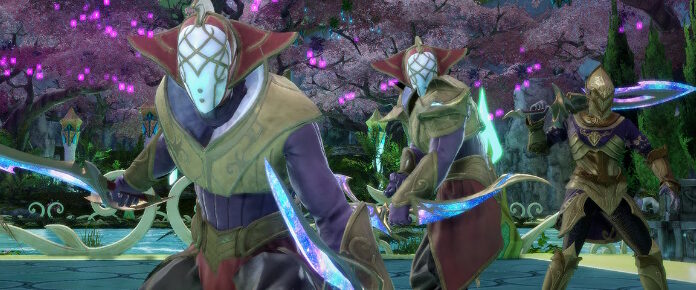
The Elder Scrolls Online continues to pump out content at an alarming rate, but the update that most players look forward to the most every year is the annual zone/story release. This year, ZeniMax has taken us on a nostalgia tour of Oblivion with the Blackwood chapter. I don’t know whether it’s because my expectations were tempered coming off the Skyrim-ish content from last year, but I was pleasantly surprised by what ESO had to offer with this update. From the stories within the zone itself to the incomparable companion system, this chapter feels incredibly tight and enjoyable.
First of all, I should clarify that my expectations were not lowered because Greymoor was a bad release. On the contrary, I enjoyed that chapter quite a bit. Rather, I assumed that Skyrim would be a very difficult zone to follow, and that whatever ZeniMax came up with would pale in comparison to the familiar towns and countryside we were introduced to in 2020. However, to my relief, the follow-up surpasses even the snowy regions of the Nords.
I’ll start with the most tedious and most contentious statement of this entire piece: As a guide for the chapter story, Eveli Sharp-Arrow is better than Lyris. Lyris is big and bad and awesome and holds an iconic status within the lore, sure. But Eveli is more whimsical and likable. She’s mischievous and a bit naïve but very competent. I loved every quest we shared together.
Possibly the most highly anticipated and best-implemented feature of the Blackwood chapter is the companion system. The single-player Elder Scrolls games have a long history of bringing the world to life through the stories of quest-givers and tag-along NPCs, so companions in ESO were long overdue. However, in previous franchise titles, the player had little control over the combat and abilities of their companions.
ESO changes all of that. With this system, companions level along with the player character and gain abilities that can be slotted into a bar. The companion bar works slightly differently in that abilities will automatically fire starting with the first slot, then the next while the first is on a cooldown, and so on until a higher-priority skill comes off cooldown, at which point the higher-priority skill will once again execute. Companions have some character-specific skills but can also unlock them for weapon and guild lines. Gear and weapons specific to companions now drops throughout the world and can be slotted in the companion character screen.

Companions are gained via specific quest lines included with the Blackwood chapter. There are currently two available, Mirri and some other guy. (Just kidding, Bastian! I know your name. Perhaps someday I’ll let you out of my collections bag.) The companions are account-bound, so they do not have to be unlocked for every character.
If none of the combat and customization for companions excites you, there is also a rapport system designed to create the feeling of forging a friendship, or even a contentious relationship, with the companion. Each companion has a “personality” that includes likes and dislikes of player actions. Certain actions will cause rapport to increase; others will cause it to decrease. As rapport increases, bonus quests can be unlocked that will reveal additional companion backstory. The trick is, the player does not know what actions will increase or decrease rapport and will have to play close attention to verbal clues from Mirri or Bastian if they desire to move the bar one way or the other.
I feel that I can’t move on from companions without comparing them to last year’s new system, antiquities. I was initially excited about the antiquities system. I thought the concept of hunting down lost items of lore would be a great distraction from the rest of the combat-heavy game. After a year of reflection, however, I find that the deficiencies in the execution of the system have become evident. The minigames for scrying/digging are still confusing at best (and annoying at worst) to me. I feel like I’m playing a mobile game that I didn’t even want to download.
The companion system, in contrast, fits very neatly into the current ESO gameplay that we’re already familiar with. It is vastly intuitive and interesting to outfit my companion with gear and skills. In fact, it integrates so well with the rest of the game that if you told me it was part of the vanilla launch, I’d believe you. The verbal quips offered by companions (my favorite so far is Mirri sarcastically proclaiming “I guess we’re in a fight now” when we attack a mob) remind me of the best parts of the old Marvel Heroes team-up system. Years down the road, I think we’ll still see players enjoying the companion system but largely ignoring antiquities.

Beyond the companionship, the story itself unfolds in such a way that I hardly gave in to the temptation to veer off into side quests. The breadcrumbs ensured I couldn’t wait to get to the next part of the storyline to find out who or what is lurking around the next corner.
We begin our journey to Leyawiin to warn former members of the Imperial Elder Council about a threat to their lives. As these members begin to fall, clues as to the reason and those responsible are slowly revealed. We’re introduced to the concept of the four Ambitions, weapons of great power that are being sought by those targeting the Elder Council, and a onetime deal with daedric prince Mehrunes Dagon that may be coming home to roost.
Each new chapter has brought a new twist on dynamic world events over the years. But whether that twist is dark anchors or geysers or even dragons, dynamic events in ESO have always felt quite similar. Enter Oblivion portals. These new types of dynamic events carry a similar flavor to the dark anchors of old, but with enough of a twist to make them feel fresh. No longer are the locations of the events marked on the world map; instead, their spawn throughout the landscape has a more random feel. Instead of being transported directly to a wave of incoming deadra, the player must fight her way through several different visually striking pieces of the Deadlands to reach the final challenge, at which point the event begins to feel familiar. It’s still an ESO dynamic event, but with a new coat of paint that spruces up the experience.

As with past chapters, previous characters make appearances, and Easter eggs abound. One such encounter leads to several interactions with a familiar face from Oblivion that left me with a grin with each conversation. ZeniMax knows its playerbase and once again excels in balancing the serious lore creation and world-building with a bit of fan service. After all, it’s a video game. It should be fun.
If it’s not already evident, I’ve enjoyed my time in Blackwood. The story is tight, the characters are likable, and there’s just a feeling of completeness and totality in the delivery. The only gripe I can think of is that companions are available only by purchasing the chapter, but from a business standpoint, even that is understandable. A chapter must deliver some differentiating features to justify the price tag, and ZeniMax knows it’s got a jewel with this one. Beyond that minor nitpick, I can’t find much to complain about. Blackwood is a solid addition to the ever-expanding world of ESO, one that I am happy to have experienced.
 Traverse the troubled land of Tamriel in the Elder Scrolls Online! Larry Everett and Ben Griggs will be your guides here in Tamriel Infinium on Wednesdays as we explore together the world created by ZeniMax and Bethesda in one of the biggest MMOs in the genre. Larry and Ben welcome questions and topic ideas!
Traverse the troubled land of Tamriel in the Elder Scrolls Online! Larry Everett and Ben Griggs will be your guides here in Tamriel Infinium on Wednesdays as we explore together the world created by ZeniMax and Bethesda in one of the biggest MMOs in the genre. Larry and Ben welcome questions and topic ideas!













